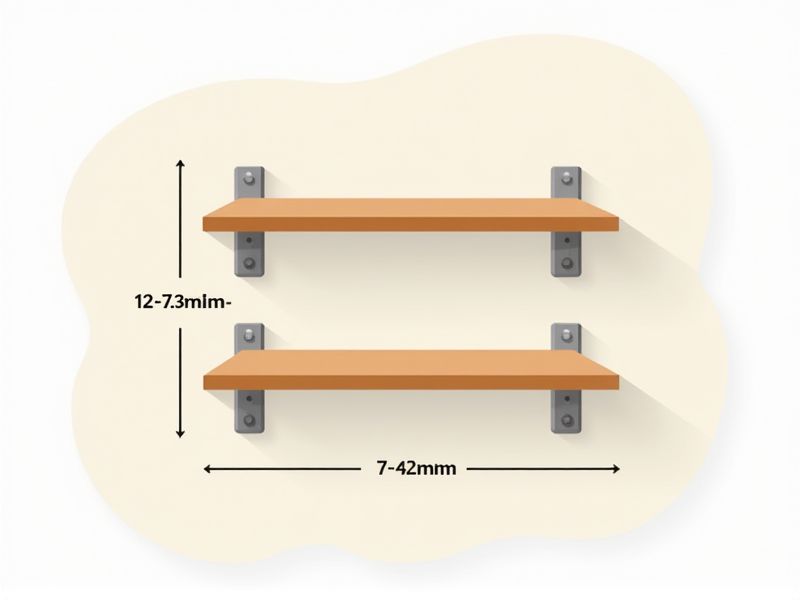
When planning pantry shelves, it's important to consider both accessibility and storage needs. Standard pantry shelf depths typically range from 12 to 16 inches, providing enough space for cans, boxes, and other pantry items without things getting lost in the back. Shelf height can be adjusted based on what you plan to store--for example, spacing shelves 12 to 18 inches apart works well for most groceries. Keeping these dimensions in mind will help you design a pantry that's both efficient and easy to organize.
Load-Bearing Capacity
A pantry shelf typically has a load-bearing capacity ranging from 50 to 150 pounds, depending on materials and construction. For optimal strength, shelves made from solid wood or metal frames are preferred over particleboard or thin MDF. To ensure safety, evenly distribute items, and avoid placing excessive weight on the edges, which can lead to sagging or damage. Regularly inspect your pantry shelves for signs of wear, such as bowing or cracking, to maintain their durability and functionality.
Depth Of Shelves
The standard depth of pantry shelves typically ranges from 12 to 24 inches, allowing for efficient organization and easy access to food items. A depth of 16 to 18 inches is optimal, as it accommodates most canned goods and containers without wasting space. When planning your pantry, consider adjustable shelving systems; these provide flexibility for varying item sizes and better utilization of vertical space. Properly utilized shelf depth can significantly enhance your pantry's functionality, ensuring you have quick access to ingredients while minimizing clutter.
Adjustable Shelf Flexibility
An adjustable pantry shelf offers tremendous flexibility, allowing you to customize the space according to your storage needs. Typically, these shelves can be repositioned at intervals of 1 to 2 inches, accommodating items of various heights, from small jars to larger containers. You can maximize storage efficiency in a pantry measuring 5 feet by 3 feet by utilizing adjustable shelves to create room for all your essentials. This versatile design not only enhances accessibility but also promotes better organization, making it easier for you to find what you need quickly.
Width Of The Unit
The standard width of a pantry shelf typically ranges from 24 to 36 inches, allowing for ample space to store items effectively. You can maximize storage by selecting adjustable shelves that can be spaced 12 to 18 inches apart, accommodating tall items like cereal boxes or canned goods. A unit with a width of 30 inches can hold over 100 pounds of weight, depending on material and construction quality. Optimizing your pantry's width and shelf height can enhance organization and accessibility for all your culinary essentials.
Shelf Spacing
When organizing your pantry, prioritize shelf spacing to maximize utility and accessibility. Ideal shelf height ranges from 12 to 18 inches apart, allowing easy access to frequently used items while accommodating larger containers. For optimal storage, consider using adjustable shelves that can be repositioned to make room for various products like jars, cans, and bulk foods. A well-spaced pantry not only enhances organization but also improves your kitchen efficiency, ultimately saving you time during meal preparation.
Height Of Installation
The standard height for installing pantry shelves typically ranges from 12 to 15 inches apart, allowing for easy access to your food items. For optimal organization, the top shelf should ideally be between 60 and 72 inches from the floor, depending on your height and reach. Adjustable shelving units are popular, enabling you to customize the space according to your storage needs. You might consider installing the bottom shelf around 18 inches above the ground, providing a comfortable area for heavier items while maximizing vertical space.
Material Durability
The standard for pantry shelves emphasizes material durability, with high-performance options like engineered wood or heavy-duty metal commonly used to ensure longevity. For instance, commercial-grade shelves can support weights of up to 500 pounds, making them suitable for storing bulk items. Maintaining moisture resistance is crucial; materials often feature finishes or coatings that prevent warping and deterioration in humid environments. When selecting your pantry shelves, ensure they meet these durability standards for optimal functionality and longevity.
Finish And Aesthetics
A well-designed pantry shelf prioritizes both finish and aesthetics, enhancing your kitchen's overall appeal. Choose materials such as sturdy wood or durable metal, ideally with a smooth finish that resists wear and tear, contributing to longevity of 5 to 10 years. Incorporating color schemes that complement your kitchen decor can create a cohesive look, making it visually pleasing. You should consider adjustable shelves, allowing for versatile storage solutions that accommodate various sizes of pantry items while maintaining an organized appearance.
Accessibility Features
A well-designed pantry shelf should prioritize accessibility features to enhance usability for all individuals. Employing adjustable shelving heights allows you to customize space for easy reach, accommodating various user heights and mobility constraints. Incorporating pull-out drawers and lazy Susans can maximize storage efficiency while minimizing the need for bending or stretching. Opting for clear storage containers enables easy visibility, making it simple to locate items quickly, ensuring a streamlined cooking experience.
Installation Method
A standard pantry shelf is typically installed using adjustable brackets that can accommodate various heights, providing customizable storage solutions for your kitchen. Installation often requires simple tools such as a drill, level, and measuring tape to ensure precise alignment and stability. Most shelves can support weights up to 250 pounds, making them sturdy enough for canned goods and appliances. For best results, you should ensure that the shelves are anchored securely into wall studs, enhancing their load-bearing capacity and durability.
